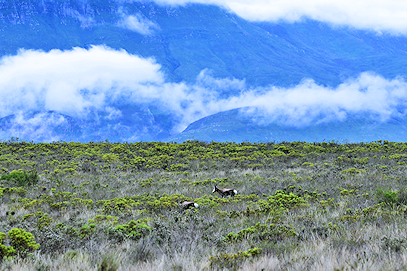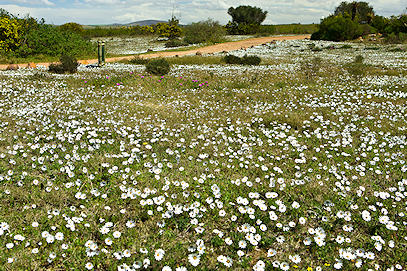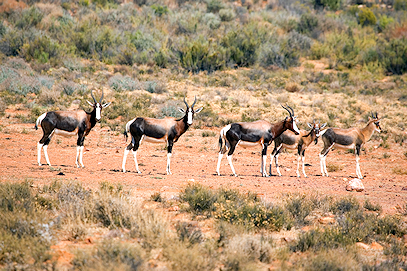South Africa's Bontebok National Park
Help Me Plan- Home
- >
- African Travel
- >
- South Africa
- >
- National Parks
- >
- Bontebok National Park
Bontebok National Park Destination Guide
A couple of centuries ago, hunters drove bontebok to the brink of extinction. Local farmers safeguarded a remnant population, and in 1931 the national park was proclaimed. Today, the reserve conserves endangered renosterveld and fynbos, protects bontebok, and offers gentle trails, river views, and rewarding birding—a compact conservation success story in the Western Cape.
Getting There
By Air: Traveling to Bontebok National Park will start in either Cape Town or George, depending on your tour choice. It is the smallest of the national parks, and we recommend combining the park with other destinations in the area. It is easily accessible from both sides, with flights available daily between OR Tambo, Cape Town, and George International airports. In both instances, the drive is roughly two and a half hours.
By Road: You are transferred to Bontebok National Park in your own private, air-conditioned vehicle from either the George or Cape Town International Airport or an alternative park or reserve on your chosen safari. The park is approximately two and a half hours from both airports, and the routes are characterized by the striking panoramic scenery of the Western Cape region.
Weather & Best Time To Visit
The region is well known for its moderate climate, with dry, hot summers and rainy winters accompanied frequently by mild winds. The coastline is extremely popular in summer among South Africans and foreigners, especially during the summer holidays, because of the comfortable summer conditions.
It is best to visit the park at the end of the rainy winter through late spring, between July and October, when the Cape fynbos and the revered proteas are in bloom. During this time, migratory birds also start visiting the park for their annual summer in the south, and many antelope have their young.

There are nearly 500 different plant species in the park, including a variety of proteas and pincushions known as leucospermum. Indigenous tree species line the Breede River, including sweet thorn, Breede River yellowwood, boekenhout, wild olive, and milkwood. Jackal and fox prowl the renosterveld, which dominates the low shrub and grassland vegetation in this transitional fynbos region.
Reasons to visit Bontebok National Park
Conservation Breakthrough
Although it is known for many attractions today, Bontebok National Park has a single purpose—saving its namesake, the bontebok, from near extinction. It is a testament to how the conservation efforts of a small group can make an enormous contribution. Visitors witness a success many once thought impossible.
Extinct to Rare
A safari in Bontebok National Park is different from most in South Africa—not just because of bontebok and the unique fynbos environment, but also the prevalence of other rare wildlife such as Cape mountain zebra, grey rhebok, and notable birdlife.
The Beautiful Breede
One of South Africa's best-known rivers, the Breede River, flows through the park. It provides peaceful charm and adventurous allure. Recreational fishing and kayaking are popular; birdwatchers often paddle along the riverine vegetation, and a dip on a hot summer day is simply sensational.
Experiences to Savor at Bontebok National Park
Savor the opportunity to stroll through a wildlife-rich but predator-free national park with its unique natural spoils when visiting Bontebok National Park. The experiences are oriented around taking advantage of the pristine surroundings.

Wander where you wish
Unlike many other parks in South Africa, Bontebok is open to wandering along signed trails. A variety of routes are available, covering different fitness levels. The Acacia Route (1.6 km) is the shortest mapped route. It embraces beautiful vegetation and is easy to complete, even for less experienced hikers.
A Blanket of Tranquility
From the serene waters of the Breede River to the absence of large carnivores – the caracal or “rooikat” is the largest found in the park – the beauty of the fauna and flora and the songs of the wide assortment of birds create a place where visitors leave feeling rested.
Unique Sightings
The bontebok has a striking appearance: chocolate-brown tones, a central dark facial blaze, and a vivid white rump that acts as a ‘follow me’ signal for young. You’ll often find visitors pausing to admire this rare antelope in all its colorful glory.Useful Information
History
Thousands of years ago, as was customary for the historic Khoi-khoi people of Southern Africa, nomadic communities settled close to life-giving waters. The Breede River was a perfect location for the Hessequa herders of sheep and cattle, and Bontebok National Park lies where two Hessequa captains and their people lived. The arrival of European settlers soon after their arrival at the Cape of Good Hope proved disastrous—disease, addiction, and rivalry reduced the community to a fraction of its once powerful clan. The park works hard to protect its cultural history as well.
Agriculture is prevalent in the Overberg; the mineral-rich lands have been used as grazing since people arrived. The arrival of European farmers and their guns spelled doom for wildlife. Bontebok were hunted until the species neared extinction. After the scale of destruction became clear, local landowners set up private reserves. In 1931, with just 17 bontebok left, the national park was established; today these beautiful antelope are seen in healthy numbers throughout the park.
Wildlife
As the name indicates, the park is best known for bontebok that roam the region. Many other plains game join these magnificent antelope on the park grounds, including the unusual Cape mountain zebra, grey rhebok, red hartebeest, grysbok, and steenbok. Carnivores are harder to find because of their nocturnal habits, but the caracal, aardwolf, Cape fox, and bat-eared fox frequent the area.
Birding in the park is exceptional; you can look forward to seeing blue crane, secretarybird, malachite and pearl-breasted swallow, to name a few. The river valley also hosts water thick-knee and makes a perfect home for the Cape clawless otter. The region is also home to various reptiles, including venomous snakes such as the puff adder. Snakes are shy and tend to avoid humans, but be vigilant at all times, especially when hiking or venturing into unpopulated areas.
Vegetation & Terrain
Bontebok National Park falls within the prolific Cape Floral Kingdom that is part of the fynbos biome and conserves critically endangered fynbos species such as renosterveld, found nowhere else on earth. Despite an initially muted palette, closer inspection reveals a remarkable assortment of fauna and flora. A medley of multicolored wildflowers and the famous protea can be seen seasonally. With over ~500 plant species and many threatened taxa, conservation focus is not limited to animals alone.
Nestled between the Langeberg Mountains and the Western Cape coastline, a couple of kilometers from Swellendam, the park and its rolling hills are a testament to dedicated conservation efforts. Unusually for a national park, Bontebok was physically moved from its original site once it was discovered that the initial location was unsuitable—today’s setting along the Breede River better supports the habitat needs of bontebok and renosterveld.
Activities
Bontebok National Park is extremely popular among hikers. Signed routes range from 1.6 km to 5.5 km and are easy to moderate in difficulty. Game viewing and bird watching are rewarding year-round, with spring often exceptional when antelope rear young, flowers bloom, and migratory birds arrive. Mountain biking on designated routes is a great way to see more of the park.
Water-based activities are available in the area, including canoeing, fishing, water-based birdwatching, and non-motorized boating. A picnic near the river or a local ‘braai’ at a designated area is a perfect way to relax while taking in the surroundings. Swimming in the river is allowed at your own risk. If you’d like to participate in a specific activity, please contact us so we can arrange the necessary equipment.









